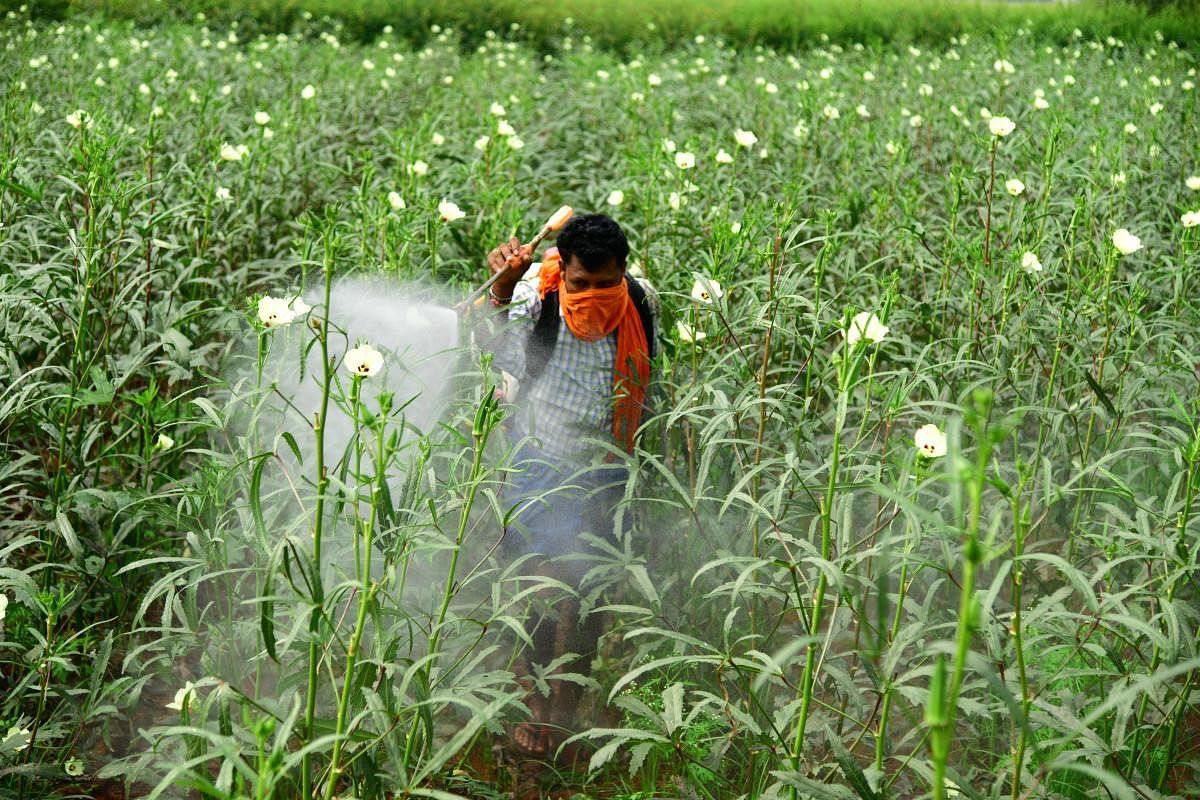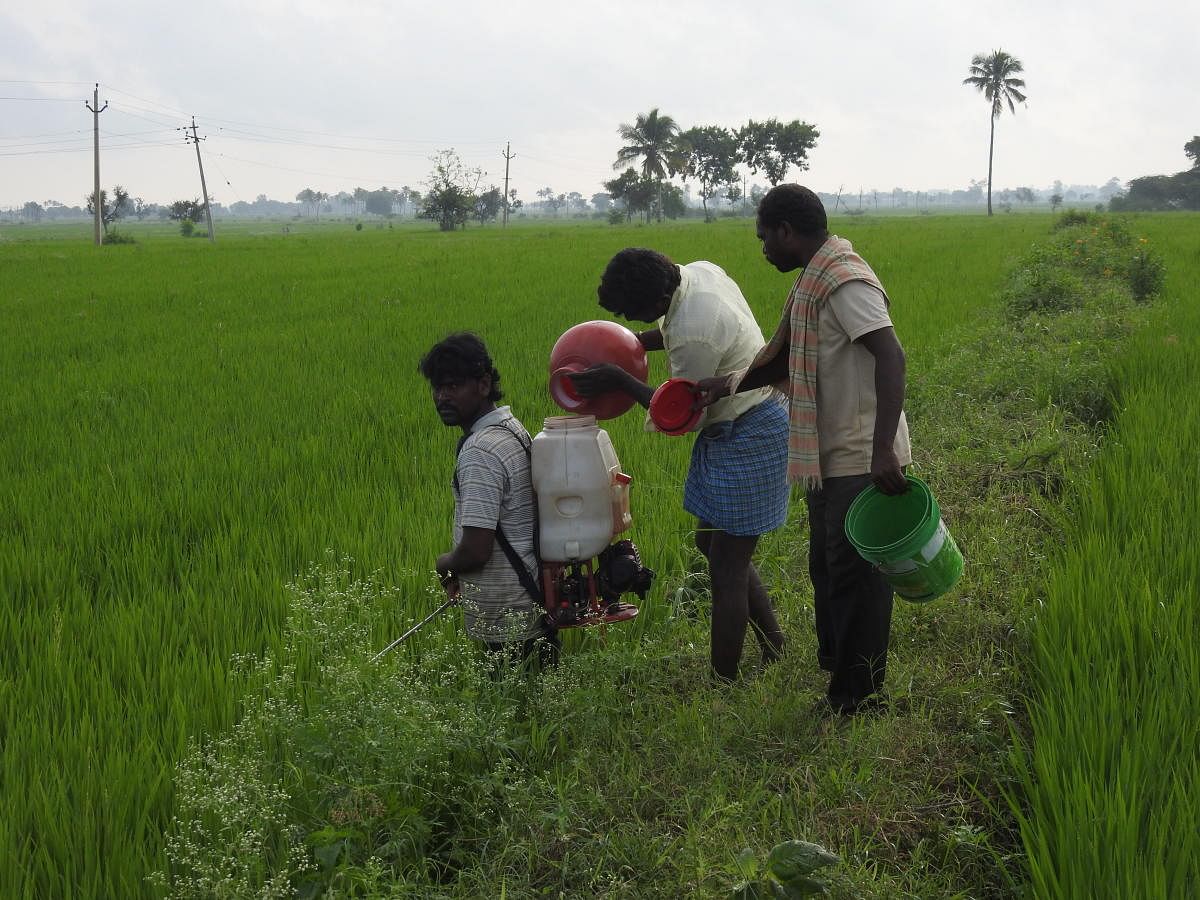

Basavaraj, 28, has no option but to choose crop growth over his health. This farmer from Goudanabavi village in Sindhanur taluk of Raichur district has been cultivating paddy and maize on leased land for the past 10 years. He has suffered acute organophosphorus poisoning (OP poisoning) thrice so far.
It takes a minimum of one month for him to recover after each spell of acute poisoning. He visits the doctor at least five times every season to get treatment for mild poisoning. “We are caught in this trap, we don’t see a way out,” he told DH.
Two hundred kilometres away, in Itagi village of Haveri district, Sithamma (name changed) is overcome by constant guilt that she is forced to spray toxic pesticides to save her crop of curry leaves considered healthy by consumers. Sithamma and many others in the village who grow vegetables and fruits are forced to overlook the pre-harvest interval (the recommended wait period between a pesticide spray and the harvest time) to reap a ‘good’ harvest.
Also Read: How scientific is our outlook?
While farmers come in direct contact with these hazardous chemicals, people consume high levels of pesticide residues with no clue about it.
From paddy, tur dal and sugarcane to almost all fruits, vegetables and spices, our food comes laced with deadly chemicals. Data from Ramaiah Advanced Testing Lab in Bengaluru shows that residues of over 25 toxic pesticides — such as DDT, monocrotophos and phorate — are found above the maximum residue limit in the agricultural and horticultural produce we eat every day.
The State Agriculture Department which grants a licence to pesticide sale in the state doesn’t have a system in place to gather information about the quantity and mode of consumption of pesticides, fungicides and herbicides in Karnataka and depends on the data provided by the Karnataka Pesticide Manufacturers
Association.
Scientists, activists and medical practitioners say that there is a dearth of substantive studies in the state to assess the impact of hazardous chemicals on the ecosystem, human health and livestock. Amidst all this, the industry is flourishing.
However, the consequences of unsafe and unscientific use of synthetic chemicals are there for us to see.
Acute illness due to pesticide poisoning is common in areas where paddy, maize, cotton, grapes, tur dal and many other crops are grown.
Consider the situation in the rice bowl of Karnataka. During the paddy season that lasts for about four months, hospitals from Maski in Raichur district to Gangavathi in Koppal district, get thousands of pesticide poisoning patients.
Also Read: Risk of multiple pesticide residues
“Pesticide poisoning may induce multisystem toxicity. Many a time, the situation is so critical that we don’t even get time to inform the police though it is mandatory. So we can’t reveal the exact numbers, too,” said a doctor at a hospital in Maski.
A 2019 study by the Pesticide Action Network Asia Pacific on the Highly Hazardous Pesticide Use and its Impacts in Asia shows 80% of farmers engaged in spraying have direct contact with pesticides. Almost half of the people spray pesticides against the wind direction.
“In this season, we have admitted over 50 people from our village to various clinics and hospitals,” said Suresh Harasur and Siddappa Mullur of Belaganur village in Maski taluk. In this belt, there are identified volunteers in every locality who arrange for immediate medical treatment and then there are also doctors known to give effective antidotes for pesticide poisoning. Still, in certain cases, the impact is so lethal that a few succumb to poisoning.
No check
The recent deaths due to monocrotophos poisoning in a temple in Chamarajanagar shows that there is no check on the accessibility and use of this highly toxic pesticide in the state.
As per the National Crime Records Bureau data, there were 7,672 cases of poisoning due to accidental intake of pesticides and insecticides in 2015. Out of them, 7,060 people died. With 1,030 such cases, Karnataka ranks third among the states in the country only after Maharashtra and Madhya Pradesh.
Monocrotophos is among the pesticides farmers in Haveri district use to control thrips and mites in cauliflower and chilli. They don’t know that this synthetic pesticide which is acutely toxic for birds and mammals has been restricted for use on vegetables.
Monocrotophos is one of the Class I pesticides (extremely hazardous and highly hazardous) that are heavily used in India but are banned in many other countries.
Over 50% of the farmer participants of a sample study done recently by the Karnataka Agricultural Price Commission in collaboration with Kasturba Medical College, Manipal and Krishi Vignana Kendras have high pesticide residual content in their bodies with Haveri (81%) and Kolar (63%) districts topping the chart.
The findings of the study also contradict the popular notion that BT cotton is pest-resistant. Cotton farmers in Haveri use heavy doses of pesticides to save their crops from pests like sucking pests, bollworm and stem borer.
A long way to go
Based on the Anupam Verma Committee report which reviewed 66 pesticides, the Ministry of Agriculture and Farmers’ Welfare has issued the Pesticides (Prohibition) Order, 2018, banning 18 pesticides. While 12 pesticides have been banned with immediate effect, another six will be phased out by December 2020.
“We still have over 80 highly hazardous pesticides being used indiscriminately in the country. We need to act with a sense of urgency to ban all these pesticides,” says Ushakumari S, national coordinator, Save Our Rice campaign.
Worse, farmers in the Sindhanur-Gangavathi belt claim they get even banned synthetic pesticides.
“There are instances of farmers using more quantity of pesticides than prescribed. We have seen cases where they don’t follow the pre-harvest interval. Not adhering to restricted use is also a grey area. We are planning a regulatory mechanism to ensure the safe and proper use of these chemicals,” said Brijesh Kumar Dikshit, commissioner, Department of Agriculture.
Dangerous trend
In the last couple of months, the Agriculture Department has carried out a series of raids, listed 54 agrochemical companies that sell highly toxic concocted synthetic chemicals under the label of biopesticides, and suspended the licences of dealers to sell these products.
“The department would welcome any bioproduct that is effective. But quite a number of bioproducts are found containing a cocktail of chemicals. This is illegal, immoral and dangerous to the farmer, crop and the ecosystem,” Brijesh Kumar said.
This suggests a dangerous trend which not only violates the Insecticides Act, 1968 but also shows the mushrooming of unscrupulous companies and dealers who supply illegal pesticides.
Circumstances have made farmers more dependent on private agrochemical dealers than the Agriculture Department. According to a recent survey, the department stands at No 14 in terms of its influence over farmers whereas agrochemical dealers are the second most influential group, next to the neighbouring farmers.
Agrochemical outlets are generally thronged by farmers seeking suggestions to tackle diseases or pests. “We give appropriate ‘medicine’ based on symptoms. Since we don’t want to lose customers, we sometimes give a combination of chemicals to tackle pest, fungus and disease,” said a dealer in Maski.
This has proved costly for farmers. Basavaraj tried three different combinations for the fall armyworm pest in maize before finding a ‘solution’. Unscientific use has led to the occurrence of pests that are resistant to pesticides. “A product is effective only for a couple of years. Every year, numerous products enter the market,” said Panchaksharayya, a farmer in Gangavathi.
Consequently, the money spent on chemicals has increased over the years and now farmers in the paddy belt spend over one-fourth of the total expenditure on pesticides, fungicides and herbicides.
A majority of farmers depend on agrochemical dealers from seeds to market and even finance. “Pesticide shops have become a one-stop solution for us. But when we borrow money from them we are compelled to buy the chemicals and fertilisers they suggest,” he said.
“Irrational use of major nutrient fertilisers like urea and DAP has led to micronutrient deficiency in the soil. This aggravates the pest and disease problems in crops,” said Ashok P, senior scientist and head, Haveri Krishi Vignana Kendra.
Another area of concern is the steep rise in the consumption of weedicides. As per the Directorate of Plant Protection, Quarantine and Storage data, imported weedicide usage has increased from 224.21 mt in 2010 to 414.64 mt (provisional) in 2016. The glaring change in the table is the increase in the consumption of the controversial weedicide glyphosate, from 2 mt in 2010 to 148 mt in 2014.
Medical practitioners have observed a steep rise in the number of asthma cases in the Sindhanur-Gangavathi belt. “We also see a growing number of cases with skin allergy, cancer, neurological disorders in this region. A proper study is required to see if high pesticide use is a reason for this,” said I S Savadi, chief medical officer, sub-divisional hospital, Gangavathi.